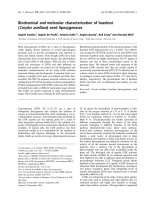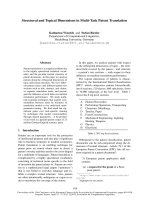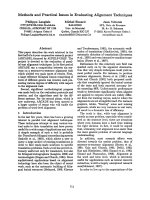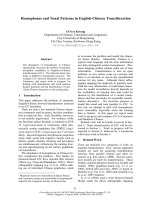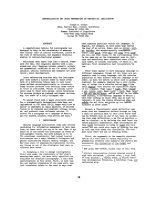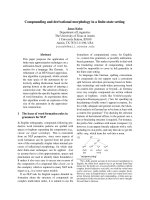Báo cáo khoa học: "Viral and Bacterial Pathogens in Bovine Respiratory Disease in Finland" pdf
Bạn đang xem bản rút gọn của tài liệu. Xem và tải ngay bản đầy đủ của tài liệu tại đây (76.18 KB, 8 trang )
Härtel H, Nikunen S, Neuvonen E, Tanskanen R, Kivelä S-L, Aho P, Soveri T, Sa-
loniemi H: Viral and bacterial pathogens in bovine respiratory disease in Finland.
Acta vet. scand. 45, 193-200. – Pathogens causing bovine respiratory tract disease in
Finland were investigated. Eighteen cattle herds with bovine respiratory disease were in-
cluded. Five diseased calves from each farm were chosen for closer examination and tra-
cheobronchial lavage. Blood samples were taken from the calves at the time of the in-
vestigation and from 86 calves 3-4 weeks later. In addition, 6-10 blood samples from
animals of different ages were collected from each herd, resulting in 169 samples.
Serum samples were tested for antibodies to bovine parainfluenza virus-3 (PIV-3),
bovine respiratory syncytial virus (BRSV), bovine coronavirus (BCV), bovine aden-
ovirus-3 (BAV-3) and bovine adenovirus-7 (BAV-7). About one third of the samples
were also tested for antibodies to bovine virus diarrhoea virus (BVDV) with negative re-
sults. Bacteria were cultured from lavage fluid and in vitro susceptibility to selected an-
timicrobials was tested. According to serological findings, PIV-3, BAV-7, BAV-3, BCV
and BRSV are common pathogens in Finnish cattle with respiratory problems. A titre
rise especially for BAV-7 and BAV-3, the dual growth of Mycoplasma dispar and Pas-
teurella multocida, were typical findings in diseased calves. Pasteurella sp. strains
showed no resistance to tested antimicrobials. Mycoplasma bovis and Mannheimia
haemolytica were not found.
bovine respiratory disease; calf; pneumonia; bacteria; virus; mycoplasma; tracheo-
bronchial lavage; seroconversion.
Acta vet. scand. 2004, 45, 193-200.
Acta vet. scand. vol. 45 no. 3-4, 2004
Viral and Bacterial Pathogens in Bovine Respiratory
Disease in Finland
By H. Härtel
1
, S. Nikunen
2
, E. Neuvonen
3
, R. Tanskanen
4
, S-L. Kivelä
5
, P. Aho
6
, T. Soveri
1
, and
H. Saloniemi
1
1
Department of Clinical Veterinary Sciences, and
4
Department of Basic Veterinary Sciences, Faculty of Veteri-
nary Medicine, University of Helsinki, and
2
Järvi-Suomen Portti,
3
Department of Virology and Epidemiology,
Virology Unit, and
5
Department of Bacteriology, and
6
Kuopio Regional Laboratory, National Veterinary and
Food Research Institute, Helsinki, Finland.
Introduction
Bovine respiratory disease (BRD) is a major
health problem of cattle worldwide. It inflicts
considerable financial losses in beef herds
(Moreno-Lopez 1990, Lekeaux 1995) and is the
most common cause of mortality in dairy cattle
(Wikse & Baker 1996). It is also an important
welfare problem of calves. The causation is
multifactorial and the disease appears to be a
result of the interaction of infectious micro-or-
ganisms and such predisposing factors as host
defence, environment and stress (Roy 1990,
Wikse & Baker 1996). Only a few reports exist
on respiratory diseases of cattle in Finland (Sih-
vonen & Tuomi 1978, Tanskanen 1987, Rikula
2000). In addition, limited field studies have
been published from other Nordic countries
(Elvander 1996, Uttenthal et al. 1996, Nor-
ström et al. 2000, Larsen et al. 2001). Finland
has a special situation, with freedom from cer-
tain aetiological agents. Infectious bovine
rhinotracheitis (IBR, BHV-1), for instance,
does not exist in Finland. Moreover, My-
coplasma bovis has not been detected in
Finnish cattle, and bovine virus diarrhoea
(BVD) is very rare (Tanskanen 1987, Anon.
2000). Vaccines against respiratory disease are
not used. Antimicrobials are generally not used
for disease prevention and sick animals are
mostly treated individually with antibiotics.
However, the traditional farming system in Fin-
land with small isolated cattle herds is chang-
ing. The dairy herds are enlarging gradually
and calves of different ages are kept in group
pens. In the new rearing system young calves at
the age of 1-3 weeks originating from several
dairy herds are transported to rearing units and
reared in large groups. The aim of this study
was to obtain basic knowledge of pathogens as-
sociated with bovine respiratory disease in Fin-
land and to evaluate the occurrence of antimi-
crobial resistance in respiratory bacteria.
Materials and methods
Sample collection
This study was conducted from November
1998 to December 1999. Eighteen cattle herds
situated in eastern, southern and western Fin-
land were included. All herds had problems
with bovine respiratory disease. Ten of the
farms were rearing dairy-bred bull calves for
beef, and 8 farms had dairy herds. The size of
the beef-raising herds varied between 48 and
217 (mean 107) animals, and the dairy herds
had 30-130 (mean 72) cows. Five diseased
calves from each farm were chosen for closer
examination, altogether 90 calves. A thorough
clinical examination and tracheobronchial
lavage were performed. The age of the diseased
calves varied from 31 to 221 (mean 98) days
and the weights were between 40 and 150
(mean 88) kg. All of the calves had abnormal
sounds on auscultation of the respiratory tract,
and most had either one or several of the fol-
lowing symptoms: fever >39.5ºC, elevated res-
piratory rate (>40/min), cough or nasal dis-
charge. One calf died 5 days after the examina-
tion and was autopsied. Blood samples for sero-
logical studies were taken from all calves at the
beginning of the study, and second samples
were taken from 86 calves 3-4 weeks later
(paired serum samples). We also collected 6-10
blood samples from other animals of different
ages on the farms to obtain more information
about the serological situation of the whole
herd. Some of the samples were taken from an-
imals aged over 6 months to avoid the influence
of maternal antibodies. The tracheobronchial
lavage was taken with a special instrument
made for collecting samples of the lower respi-
ratory tract from calves (Bengtsson et al. 1998).
The catheter was inserted nasally into the tra-
chea. As lavage fluid, we used 30-40 ml of
phosphate-buffered saline (PBS, Dulbecco`s
phosphate-buffered saline, Gibco TM, Invitro-
gen Corporation, Paisley, Scotland, UK). The
tracheobronchial fluid was immediately aspi-
rated through the catheter and removed into test
tubes with a glucose calf serum (GS) broth for
mycoplasma and transport media for bacteria
isolation (Portagerm multi-transport medium
BioMerieux, Lyon, France). The quantity of the
collected fluid varied from 2 ml to over 20 ml.
Detection of bacteria
Tracheobronchial lavage samples from 85
calves in 18 herds were tested for bacterial
growth. Samples were cultured on blood agar
(tryptose-soya-agar containing 5% bovine
blood) aerobically and anaerobically as well as
on selective agar for Histophilus somni (for-
merly Haemophilus somnus) in a CO
2
-en-
hanced atmosphere. More specific identifica-
tion was made with biochemical tests. The
susceptibility of different Pasteurella sp. iso-
lates for selected antimicrobials was tested. The
antimicrobials used were ampicillin, penicillin,
trimethoprim-sulfamethoxazole, gentamicin,
tetracycline and enrofloxacin or ciprofloxacin.
194 H. Härtel et al.
Acta vet. scand. vol. 45 no. 3-4, 2004
The bacterial tests were performed according to
the standard procedures of the National Veteri-
nary and Food Research Institute in Helsinki.
The mycoplasma samples were kept frozen at -
70ºC until cultured. The media, culturing and
identification methods used have been de-
scribed elsewhere (Tanskanen 1984). Species
identification was based on growth characteris-
tics and the selective use of an epi-immunoflu-
oresence (IF) test; only antisera against My-
coplasma dispar 462/2, Mycoplasma bovir-
hinis PG 43 and M. bovis Donetta PG 45 were
used.
Detection of viral antibodies
Altogether 345 serum samples from 259 differ-
ent animals were serologically tested for viral
antibodies. Ninety samples were collected from
diseased calves, 86 samples were paired serum
samples from the same calves and 169 samples
were taken from other cattle in the same herd.
From each farm, 7-8 samples were from calves
and 5-8 samples were from animals aged over 6
months. The serum samples were frozen at
-20ºC. They were tested for antibodies to
bovine parainfluenza virus-3 (PIV-3), bovine
respiratory syncytial virus (BRSV), bovine
coronavirus (BCV), bovine adenovirus-3 (BAV-
3) and bovine adenovirus-7 (BAV-7). In addi-
tion, 123 samples from 94 animals were tested
for antibodies to bovine virus diarrhoea virus
(BVDV). An ELISA test was used for antibod-
ies to PIV-3, BRSV, BCV and BVDV. A virus
neutralization test was used for BAV-3 and
BAV-7. The ELISA kits (SVANOVA Biotech,
Uppsala, Sweden) were used according to the
manufacturer's instructions. If a fourfold in-
crease occurred in antibody titre in the neutral-
ization test or if the ELISA test was seronega-
tive in the first sample and seropositive in the
second sample, the calf was considered to have
a rise in titre and to be recently infected with the
relevant virus.
Results
Results of the antibodies to viruses are pre-
sented in Table 1. Antibodies to PIV-3 and
BAV-7 were found in all 18 herds. Antibodies to
Pathogens in bovine respiratory disease 195
Acta vet. scand. vol. 45 no. 3-4, 2004
Table 1. Serological findings of 18 cattle herds with respiratory problems.
No. calves
(herds)
PIV3 BCV BRSV BAV3 BAV7
No. of herds positive 18 18 16 12 15 18
Percentage of positive herds 100 100 89 67 83 100
No. of diseased 90 (18) 66 (18) 35 (15) 8 (6) 46 (13) 65 (17)
calves,
1
first sampling 73%
2
38% 9% 51% 72%
No. of diseased calves,
1
86 (18) 58 (17) 30 (15) 5 (5) 44 (11) 72 (17)
second sampling 67% 35% 6% 51% 84%
No. of other animals
1
169 (18) 150 (18) 57 (14) 18 (9) 107 (15) 143 (18)
89% 34% 11% 63% 85%
Rise in titre
1
86 (18) 3 (2) 4 (3) 0 (0) 11 (5) 20 (10)
3.5% 4.7% 0% 12.8% 23.3%
Decrease in titre
1
86 (18) 9 (7) 8 (6) 3 (2) 23 (10) 20 (8)
10.5% 9.3% 3.5% 26.7% 23.3%
1
Number of herds in parentheses.
2
Percentage of calves
BCV and BAV-3 were discovered in 16/18
(89%) and from 15/18 (83%) herds, respec-
tively. Antibodies to BRSV were found in 12/18
herds (67%) and in all dairy herds. Antibodies
to BVDV were detected in 0/7 herds. High lev-
els of antibodies to BAV-7 in more than 2 sam-
ples in one herd were monitored on 14 farms
(neutralization titre more than 1:512). In paired
serum samples, a rise in titres occured in 33 of
86 calves (33%) on 15 farms. Seroconversion
for BAV-7, BAV-3, BCV and PIV-3 was seen on
10/18, 5/18, 3/18 and 2/18 farms, respectively.
Titre rise for BAV-7 was most often seen on
beef farms (8 herds) and titre rise for BAV-3
was most frequent on dairy farms (3 herds). Se-
roconversion to BRSV was not noted at any of
the farms. Decreasing antibody titres (neutral-
ization test) or a change from seropositive in the
first sample to seronegative in the paired serum
sample (ELISA test) was observed in 44 calves
(51%) on 15 farms.
All 18 herds and 93% of the calves (79/85) had
mycoplasma findings. M. dispar was found in
17 herds (94%) from 77 samples (91%), and
other mycoplasmas in 16 herds (89%) from 52
samples (61%). On 15 farms (83%) and in 50
samples (59%), M. dispar occurred together
with other mycoplasmas. All classical colonies
examined by the IF test proved to be M. bovirhi-
nis. M. bovis was not detected. Other bacterial
growth was found in 9 herds (50%) in 18 sam-
ples (21% of calves). The most common find-
ing was Pasteurella sp., which was monitored
in 14 samples (78% of positive samples) of 8
herds (44% of the herds and 17% of the calves).
The Pasteurella sp. isolates were identified as P.
multocida in 7 cases and P. multocida (indole-
negative) in 6 cases. Most often Pasteurella sp.
was the only finding, but in 2 cases it was found
together with Fusobacterium necrophorum and
once with Arcanobacterium pyogenes. F. necro-
phorum alone was found from 3 samples in 3
herds and A. pyogenes alone only from one calf
in one herd. All calves with other bacteria in
tracheobronchial fluid also had mycoplasmal
growth. M. dispar and P. multocida together
were isolated in 13 samples from 7 herds. Six
calves of these 13 showed a seroconversion to
viruses, 4 of them to BAV-3, one to BAV-7 and
one to BCV and BAV-7 simultaneously. The
post-mortem examination of the dead calf re-
vealed signs of chronic fibrinopurulent bron-
chopneumonia. H. somni was cultured from the
lungs, in contrast to P. multocida (indole-nega-
tive), which was found earlier in the tracheo-
bronchial lavage fluid. All 14 Pasteurella sp.
strains were susceptible in vitro to all antimi-
crobials tested (ampicillin, penicillin, trimetho-
prim-sulfamethoxazole, gentamicin, tetracy-
cline, enrofloxacin or ciprofloxacin).
Discussion
According to the serological findings, PIV-3,
BAV-7, BAV-3, BCV and even BRSV were
common pathogens in Finnish cattle herds with
respiratory problems. Finland is free from IBR
and the occurrence of BVD is very rare (Anon.
2000). Both of these viruses have been consid-
ered to be important BRD-associated patho-
gens elsewhere (Wikse & Baker 1996, Kapil &
Basaraba 1997, Potgier 1997, Obando et al.
1999). Our negative findings confirm that
BVDV infection is not closely linked to occur-
rence of BRD in Finland. The different
serotypes of bovine adenovirus are divided into
2 subgroups. Types 1-3 represent group A and
types 4-9 group B (Mattson 1992). We chose to
examine types 3 and 7. Our results agree with
the findings of Sihvonen & Tuomi (1978), who
demonstrated that infections with BAV-1, -2
and -3 are common in cattle, at least in the
southwestern part of Finland. To our knowledge
the occurrence of BAV-7 has not been studied
earlier in Finland. Here, seroconversion to
BAV-7 was the most common, followed by se-
roconversion to BAV-3. Many of the older ani-
196 H. Härtel et al.
Acta vet. scand. vol. 45 no. 3-4, 2004
mals, especially on the beef farms, had high
titres of BAV-7, which may indicate that an
acute infection caused by this virus has oc-
cured. Antibodies to PIV-3 were found on every
farm examined, and almost 80% of all samples
taken were positive for PIV-3. This is in agree-
ment with the ubiquitous nature of the virus,
with its world-wide distribution (Bryson 1990,
Kapil & Basaraba 1997). However, PIV-3 was
not observed to be a causal factor. BCV has
gained ground as a pathogen in respiratory dis-
ease complex recently (Storz et al. 1996, Lath-
rop et al. 2000, Storz et al. 2000). BCV may
also be involved in respiratory disease in
Finnish cattle. Antibodies to BRSV were found
in 67% of the herds overall and in all dairy
herds. However, BRSV did not appear to cause
the disease in the calves studied. The situation
might have changed after the respiratory dis-
ease outbreak in Finland in spring 2000; the
causative agents of the epidemic were sug-
gested to include BRSV and BCV (Rikula
2000). Although we detected antibodies to sev-
eral viruses on each farm and even in high
titres, we relatively seldom found seroconver-
sion in the diseased calves. This is probably be-
cause of the young age of the calves and exist-
ing maternal antibodies which may suppress the
calves` own production of antibodies. This is in
agreement with the results of a high number of
decreasing antibody titres and with the conclu-
sion of Virtala et al. (1996, 2000), who stated
that young pneumonic calves often fail to sero-
convert to agents present in respiratory tract be-
cause of suppressive maternal antibodies. Our
failure to detect seroconversions might also be
a consequence of missing the acute phase of the
disease. Seroconversion to adenoviruses was
seen in about half of the cases where also bac-
terial growth of M. dispar and P. multocida was
noticed. There might have been some other pre-
disposing factors than the viruses examined. In-
terpreting the importance of viral infection in
this study is, however, problematic because we
could not use any direct virus diagnostics from
the tracheobronchial lavage and we did not have
healthy calves or healthy herds as controls.
Mycoplasmas are considered to be one of the
pathogens causing BRD. They are able to cause
a mild respiratory disease by themselves, but
more often they are isolated from pneumonic
lungs together with other pathogens (Welsh
1993, Lauerman 1994, Walker 1995). The most
common isolate from lavage fluid of diseased
calves in our study was M. dispar. The predom-
inant combination was M. dispar and P. multo-
cida. In another study, a synergistic effect be-
tween Mycoplasma sp. and P. multocida was
suggested (Virtala et al. 1996). We found no M.
bovis which has not to date been isolated from
Finnish cattle, and most likely it does not exist
in Finland. However, many reports are available
from other countries about the increasing
prevalence of M. bovis (Brice 2000, Kusiluka
2000, Byrne 2001). The findings of M. dispar
and Mycoplasma sp. did not differ much from
previous reports in Finland. Tanskanen (1987)
described a high prevalence of mycoplasma
from nasal and transtracheal samples, and rapid
spread of the infection in a population of young
cattle. In our study, other bacteria were detected
in only 21% of the tracheobronchial samples.
Virtala et al. (1996) found in transtracheal wash
samples (TTW) bacterial growth in 90% of the
diseased calves and in 55% of the controls. M.
haemolytica biotype A serotype 1 is considered
to be the predominant and most pathogenic bac-
terium in pasteurellosis of feedlot units (Frank
1989, Mosier 1997). In our samples, we found
no M. haemolytica.
P. multocida is another common pathogen re-
ported to be involved in BRD, especially in
dairy herds (Virtala et al. 1996, Mosier 1997).
Some of our Pasteurella sp. strains differed in
biochemical tests from the typical P. multocida
by showing a negative reaction to indole. An
Pathogens in bovine respiratory disease 197
Acta vet. scand. vol. 45 no. 3-4, 2004
important finding was that all Pasteurella iso-
lates were susceptible to all of the antimicro-
bials typically used in the treatment of BRD in
Finland. An explanation for the very few bacte-
rial findings in spite of mycoplasmas may lie in
the lavage technique and the relatively small
fluid volume used. Alternatively, perhaps few
pathogens were present in the tracheobronchial
area at the time of the investigation. The post-
mortem finding of H. somni may indicate that
we failed to detect some bacteria in the tracheo-
bronchial area. However, the calf may have con-
tracted the H. somni infection after the lavage
and the P. multocida infection. Tegtmeier et al.
(1999) described H. somni as a frequent finding
in autopsied calves with respiratory disease in
Denmark. H. somni has seldom been found in
Finland, with only 10 reports in the last 10 years
and only in connection with respiratory disease
(Niskanen et al. 1999). Isolation of A. pyogenes
and F. necrophorum without any other bacteria
was considered to be a contamination or a coin-
cidental finding. No connection to the poor
prognosis of calves with A. pyogenes was seen,
in contrast to Scholz et al. (1987) and Mosier
(1997). The scant bacterial findings and low
mortality in our study may also indicate that the
severity of the disease was lower than in many
other studies.
Conclusions
According to serological findings, BAV-7, PIV-
3, BAV-3, BCV and BRSV are common viruses
in Finnish cattle herds suffering from respira-
tory disease. Seroconversion to BAV-7 and
BAV-3 occurred most often. These results sug-
gest an active role of adenoviruses, particularly
BAV-7, in respiratory diseases in cattle in Fin-
land. Antibodies to BRSV were detected
mainly in older animals without signs of respi-
ratory disease and no seroconversion. Tracheo-
bronchial lavage revealed few pathogens other
than mycoplasmas, which could be found in all
herds in this study. The most common bacterial
findings were P. multocida and M. dispar, sug-
gesting their importance in respiratory prob-
lems. How these 2 pathogens interact together
and with viral pathogens remains to be clari-
fied. M. haemolytica and M. bovis were not
found, and H. somni was only found in the lungs
of the autopsied calf. New calf-rearing systems,
where large groups of young calves are reared
in close proximity, may increase respiratory
problems considerably also in Finland. Larger
studies which will enable more information to
be gathered about respiratory diseases and the
roles of different pathogens are therefore war-
ranted.
Acknowledgements
The authors are grateful to Hannele Pentti for techni-
cal assistance, Marja-Liisa Tasanko for laboratory
assistance and Professor Satu Pyörälä for sound ad-
vice. Thanks are also given to the veterinary col-
leagues who helped us to collect blood samples. We
thank Dr. Björn Bengtsson from Sweden for kindly
giving us the model of the instrument for tracheo-
bronchial lavage. The practical study was supported
by a scholarship from Hoechst Fennica, and the my-
coplasma study by a scholarship from Pfizer Animal
Health.
References
Anonymous: Contagious animal disease in 2000. Na-
tional Veterinary and Food Research institute
EELA, Annual report 2000, 29-30.
Bengtsson B, Franklin A, Gånheim C, Jacobsson S-O,
Persson M & Viring S: A simple field method for
tracheo-bronchial lavage in calves. Proceedings
of XX World Buiatrics Congress, Sydney, 6-10
July 1998, Vol. 2, 1127.
Brice N, Finlay D, Bryson DG, Henderson J, Mc-
Connell W & Ball HJ: Isolation of Mycoplasma
bovis from cattle in Northern Ireland, 1993 to
1998. Vet. Rec. 2000, 146, 643-644.
Bryson DG: Parainfluenza-3 Virus in Cattle. In: Din-
ter Z & Morein B (eds): Virus infections in Ru-
minants, Elsevier publishers, Amsterdam, 1990,
319-333.
Byrne WJ, McCormack R, Brice N, Egan J, Markey B
& Ball HJ: Isolation of Mycoplasma bovis from
198 H. Härtel et al.
Acta vet. scand. vol. 45 no. 3-4, 2004
bovine clinical samples in the Republic of Ire-
land. Vet. Rec. 2001, 148, 331-333.
Elvander M: Severe respiratory disease in dairy cows
caused by infection with bovine respiratory syn-
cytial virus. Vet. Rec. 1996, 138, 101-105.
Frank GH: Pasteurellosis of Cattle. In: Adlam C &
Rutter JM (eds): Pasteurella and Pasteurellosis,
Academic Press, London, 1989, 197-222.
Kapil S & Basaraba RJ: Infectious bovine rhinotra-
cheitis, parainfluenza-3, and respiratory coron-
avirus. Bovine respiratory disease update. Vet.
Clin. North Am. Food An. Pract. 1997, 13, 455-
469.
Kusiluka LJM, Ojeniyi B & Friis NF: Increasing
prevalence of Mycoplasma bovis in Danish cat-
tle. Acta vet. Scand. 2000, 41, 139-146.
Larsen LE, Tegtmeier C & Pedersen E: Bovine respi-
ratory syncytial virus (BRSV), Pneumonia in
beef calf herds despite vaccination. Acta vet.
Scand. 2001, 42, 113-121.
Lathrop SL, Wittum TE, Brock KV, Loerch SC, Perino
LJ, Bingham HR, McCollum FT & Saif LJ: Asso-
ciation between infection of respiratory tract at-
tributable to bovine coronavirus and health and
growth performance of cattle in feedlots. Am. J.
Vet. Res. 2000, 61, 1062-1066.
Lauerman LH: Mycoplasmas of the bovine respira-
tory tract. In: Whitford HW, Rosenbusch RF,
Lauerman LH (eds): Mycoplasmosis in animals.
Iowa State University Press, Ames, 1994, 50-56.
Lekeaux P: Bovine respiratory disease complex: A
European perspective. Bov. Pract. 1995, 29, 71-
75.
Mattson DE: Adenoviruses, In: Castro AE &
Heuschele WP, (eds). Veterinary diagnostic virol-
ogy, a practitioner's guide. Mosby, St. Louis,
1992, 70-72.
Moreno-Lopez J: Acute respiratory disease in cattle.
In: Dinter Z & Morein B (eds). Virus infections
in ruminants, Elsevier publishers. B.V., Amster-
dam, 1990, 551-554.
Mosier DA: Bacterial pneumonia. Vet Clin. North
Am. Food An. Pract. 1997, 13, 483-493.
Niskanen M, Salmela P, Hirvelä-Koski V & Kuronen
H: Haemophilus somnus -bakteeri vasikan keuh-
kotulehdusten aiheuttajana Suomessa. Haemo-
philus somnus as a cause of calf pneumonia in
Finland. Suom. Eläinlääkäril. 1999, 11, 578-580.
(In Finnish).
Norström M, Skjerve E & Jarp J: Risk factors for epi-
demic respiratory disease in Norwegian cattle
herds. Prev. Vet. Med. 2000, 44, 87-96.
Obando C, Baule C, Pedrique C, Veracierta C, Belák
S, Merza M & Moreno-Lopez J: Serological and
molecular diagnosis of bovine viral infections in
dairy calves with respiratory disease in Vene-
zuela. Acta. vet. Scand. 1999, 40, 243-262.
Potgier LND: Bovine respiratory tract disease caused
by bovine viral diarrhea virus. Vet. Clin. North
Am. Food An. Pract. 1997, 13, 471-481.
Rikula U: Naudan RS- ja koronavirusvasta-aineiden
esiintyminen Suomen lypsykarjoissa kevät-
talvella 2000, Prevalence of antibodies against
bovine respiratory syncytial virus and coron-
avirus in Finnish dairy herds in early spring 2000,
Suom. Eläinlääkäril. 2000, 12, 712-715. (In
Finnish).
Roy JHB: Respiratory infections. In: Roy JHB: The
Calf, Management of Health, Butterworths, Lon-
don, 1990, 132-153.
Scholz H, Amtsberg U, Westermilies A, Binder A &
Kirchhoff H: Untersuchungen zur Bronchopneu-
monie des Rindes, 1. Versuchsanstellung und
mikrobieller Status von Nasen- und Tracheo-
bronchialsekret. Investigations to bovine respira-
tory disease. 1. Experimental procedure and mi-
crobiological findings in nasal and trache-
obronchial secretion. Tierärztl. Umschau 1987,
42, 272-280. (In German).
Sihvonen L & Tuomi J: A seroepidemiological sur-
vey of adenovirus activity (types 1-3) at two
Finnish calf-rearing farms. Acta. vet. Scand.
1978, 19,
192-203.
Storz J, Stine L, Liem A & Anderson GA: Coronavirus
isolation from nasal swab samples in cattle with
signs of respiratory tract disease after shipping. J.
Am. Vet. Med. Assoc. 1996, 208, 1452-1455.
Storz J, Lin X, Purdy CW, Chouljenko VN, Kousoulas
KG, Enright FM, Gilmore WC, Briggs RE &
Loan RW: Coronavirus and pasteurella infections
in bovine shipping fever pneumonia and Evans`
criteria for causation. J. Clin. Microbiol. 2000,
38, 3291-3298.
Tanskanen R: Colonisation pattern of the respiratory
tract of calves by Mycoplasma dispar. Acta vet.
scand. 1984, 25, 577-592.
Tanskanen R: Experimental and epidemiological
studies on mycoplasma dispar infection in calves.
Diss., Coll. Vet. Med. Helsinki 1987. 68p.
Tegtmeir C, Uttenthal A, Friis NF, Jensen NE &
Jensen HE: Pathological and microbiological
studies on pneumonic lungs from Danish calves.
J. Vet. Med. B. 1999, 46, 693-700.
Uttenthal A, Jensen NPB & Blom JY: Viral aetiology
Pathogens in bovine respiratory disease 199
Acta vet. scand. vol. 45 no. 3-4, 2004
of enzootic pneumonia in Dainish dairy herds: di-
agnostic tools and epidemiology. Vet. Rec. 1996,
139, 114-117.
Virtala A-MK, Mechor GD, Gröhn YT, Erb HN &
Dubovi EJ: Epidemiologic and pathologic char-
acteristics of respiratory tract disease in dairy
heifers during the first three months of life. J. Am.
Vet. Med. Assoc. 1996, 208, 2035-2042.
Virtala A-MK, Gröhn YT, Mechor GD, Erb HN &
Dubovi EJ: Association of seroconversion with
isolation of agents in transtracheal wash fluids
collected From pneumonic calves less than three
months of age. The Bov. Pract. 2000, 34, 77-80.
Walker RL: Bovine Mycoplasmosis: Current per-
spectives, proceedings of the 27th annual con-
vention American association of bovine practi-
tioners, 1995, 27, 3-7.
Welsh RD: Bacterial and mycoplasma species iso-
lated from pneumonic bovine lungs. Agri Prac-
tice, 1993, 14, 3-16.
Wikse SE & Baker JC: The bronchopneumonias. In:
Smith BP (ed.) Large Animal Internal Medicinen,
2. ed. Mosby, St. Louis, 1996, 632-650.
Sammanfattning
Förekomst av luftvägspatogener vid enzootisk pneu-
moni i finska nötbesättningar.
Studien genomfördes under åren 1998-1999 för att få
grundkunskap om förekomsten av infektionsämnen
associerade med kalvarnas luftvägsinfektioner i Fin-
land. Alla 18 besättningarna hade problem med luft-
vägssjukdomar. I varje besättning utvaldes 5 sjuka
kalvar för noggrann undersökning och tracheobron-
kiell sköljning. För serologiska undersökningar av
virusantikroppar togs blodprov från 86 kalvar med 3-
4 veckors mellanrum. Från samma besättningar togs
dessutom 6-10 serumprov från nöt i olika ålders-
grupper, sammanlagt 169 prov. Serumproverna ana-
lyserades för antikroppar mot parainfluensavirus typ
3 (PIV-3), bovint respiratoriskt syncytialt virus
(BRSV), bovint coronavirus (BCV), bovint adenovi-
rus typ 3 (BAV-3) och bovint adenovirus typ 7 (BAV-
7). En tredjedel av proverna analyserades dessutom
på antikroppar mot bovint virusdiarrevirus (BVDV)
med negativt resultat. De tracheobronkiella skjölpro-
verna undersöktes på mykoplasmer och andra bakte-
rier. Enligt serologiska resultat tycks PIV-3, BAV-7,
BAV-3, BCV och BRSV förekomma allmänt hos be-
sättningar med luftvägssjukdomar i Finland. Sero-
konversion konstaterades oftast mot BAV-7 och BAV-
3. I bakteriologiska undersökningar av sköljproven
isolerades bara få patogener. De mest allmänna bak-
terieisolaten var Mycoplasma dispar och Pasteurella
multocida tillsammans. Alla Pasteurella sp. isolat var
känsliga för testade antibiotika. Mannheimia haemo-
lytica och M. bovis kunde inte påvisas i något prov.
200 H. Härtel et al.
Acta vet. scand. vol. 45 no. 3-4, 2004
(Received June 7, 2004; accepted September 13, 2004).
Reprints may be obtained from: Heidi Härtel, LSO Foods Oy, Animal Health Service, Turuntie 4, 30100 Forssa,
Finland. E-mail: heidi.hartel@lso.fi, tel: +358 3 415 9307, fax +358 3 433 4363.
